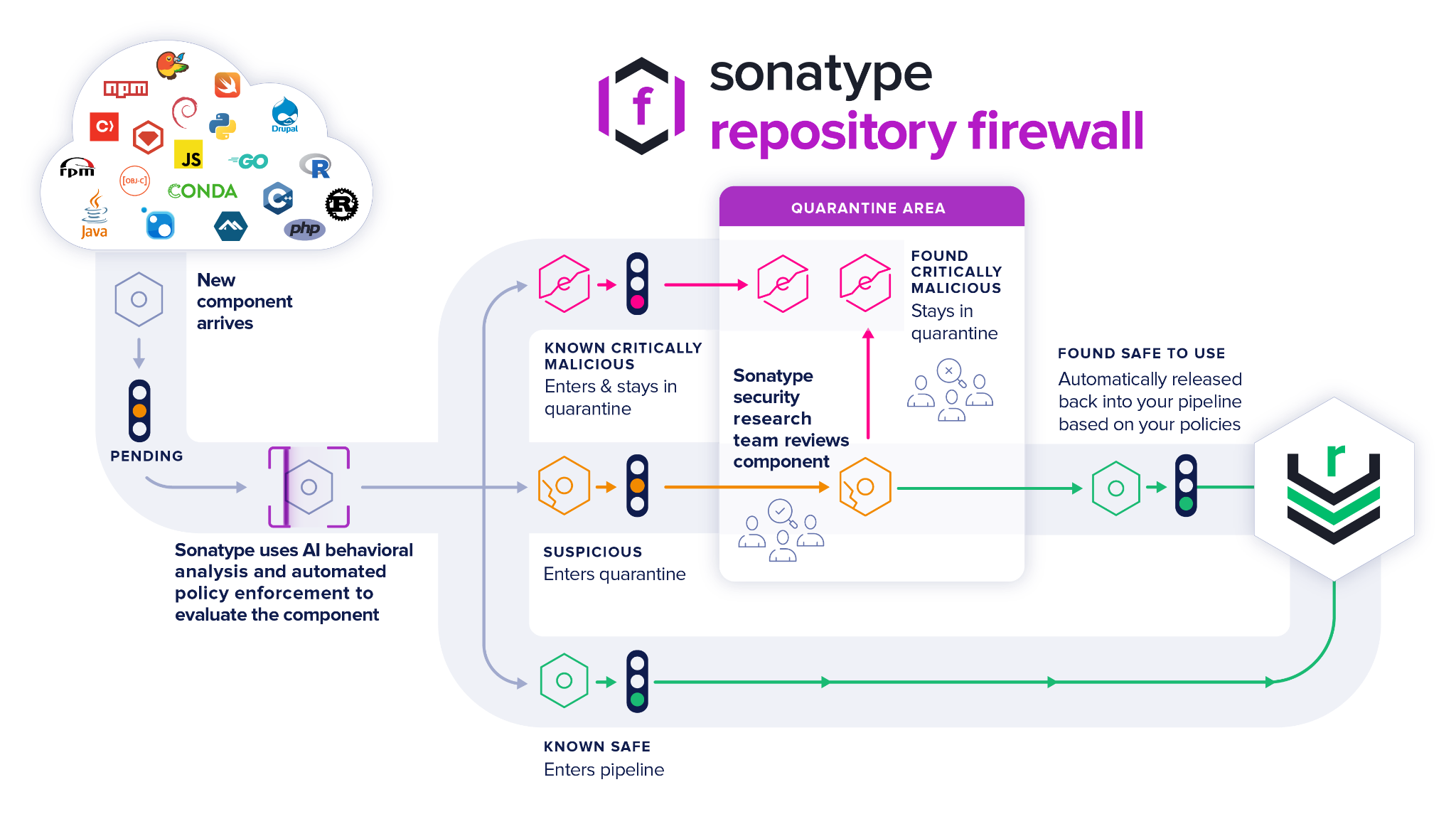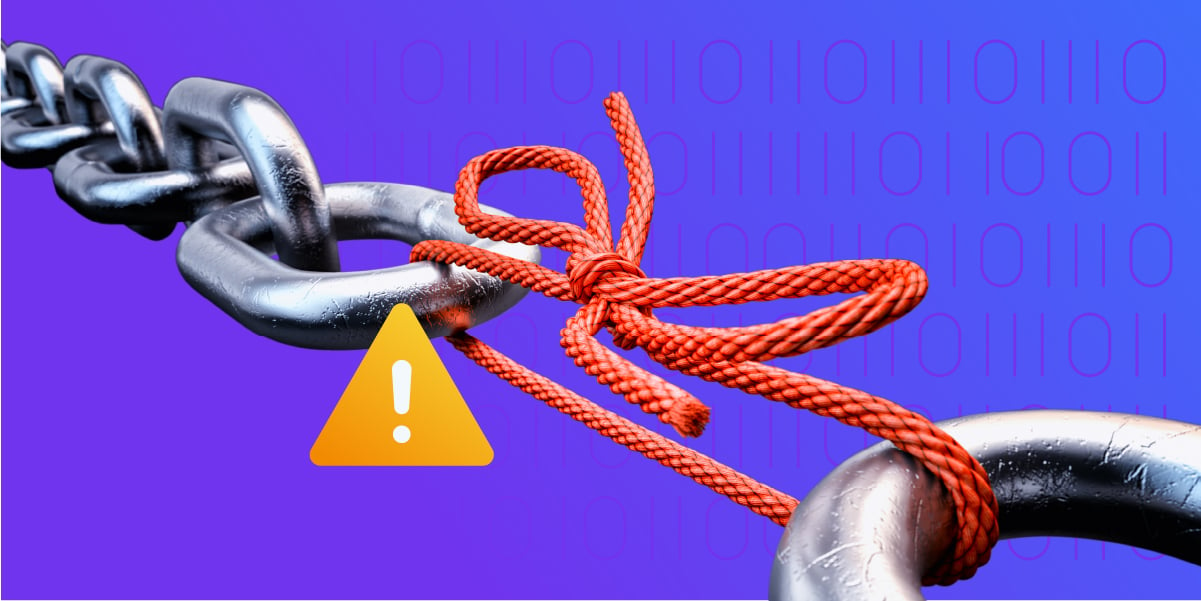In a world where 29% of popular projects contain vulnerabilities, and the Biden-Harris National Cybersecurity Strategy pushes organizations to prioritize security, having a solution to protect your software supply chain isn’t just a friendly recommendation. At this point, it’s a necessity.
Initially, it might sound a little hyperbolic to say that we’re a step ahead of the competition in solving this problem. But consider this: we have a secret weapon–Sonatype Repository Firewall. It’s a one-of-a-kind, the only repository firewall designed specifically for software supply chain management.
While some competitors offer protection against known vulnerabilities, they often fail to identify and block malicious or suspicious components. These offerings simply can’t compete with Repository Firewall’s use of advanced AI and data-driven insights to proactively stop malicious and suspicious components from sneaking into your software development life cycle (SDLC).
This post will cover the following:
- How Sonatype’s AI-driven early identification and vulnerability warnings ensure your organization stays one step ahead of potential threats.
- The crucial difference between malware and vulnerabilities and how Repository Firewall offers protection against both.
- The benefits of automated monitoring and policy enforcement.
- Ease of integration with your organization’s tech stack.
- How Firewall’s flexible deployment options cater to various security requirements and deployment scenarios.
Let’s dive into the details.
Early identification and vulnerability warnings keep unidentified threats out of the SDLC
Sonatype’s Artificial Intelligence continuously evaluates millions of newly released open source software components, every code commit, and package publication to keep unidentified threats at bay.
When Repository Firewall’s AI detects abnormal behavior indicating malicious activity, four things happen:
- Components are marked as suspicious.
- Suspicious components are removed from the software supply chain and placed in quarantine.
- Human researchers validate whether the suspicious components are malicious or not.
- Components confirmed as malicious remain quarantined and blocked, while safe ones are automatically released.

Don’t mistake vulnerabilities for malware
Understanding the difference between a vulnerability and malware is essential in ensuring software security. Vulnerabilities are weaknesses or flaws in otherwise suitable components that attackers can exploit, while malware is intentionally designed for malicious purposes. A component may have an inherent vulnerability that can be fixed or contain a maliciously submitted vulnerability. In both cases, the component itself may not be inherently malicious.
More than just relying on protection against vulnerable components is required. To safeguard against all three scenarios—vulnerabilities, malware, and maliciously submitted vulnerabilities—Sonatype Repository Firewall is necessary. Over 101,000 malicious packages have been identified and blocked using our next-generation, proprietary behavioral analysis and automated policy enforcement.
Automated monitoring and policy enforcement lessens the risk of security breaches
So you’ve been issued a warning about a newly discovered malicious package. What’s next?
In most cases, there’s nothing for Sonatype Repository Firewall users to worry about because default policy settings automatically block malicious components from entering your supply chain. And this can be achieved without manual tasks–something your development and security teams will thank you for.
Your next question might be: what about vulnerabilities? But don’t worry, Sonatype Repository Firewall has numerous automated policy and enforcement capabilities:
- Set policy based on risk tolerance - Firewall allows organizations to customize their policy settings. Assessing factors like component age, popularity, and licensing credentials helps make informed decisions about which components are allowed into their SDLC.
- Protect against the unknown - Sonatype Repository Firewall can block components before they are publicly disclosed as vulnerable. This proactive approach helps users avoid emerging threats and potential security breaches while minimizing the impact of undiscovered vulnerabilities.
- Ensure automatic compliance - Firewall allows users to prevent applications from progressing with unwanted or unapproved components. This helps development processes adhere to security policies and reduces the risk of introducing vulnerabilities into applications.
Frictionless integration helps organizations shift left
One of the best things an organization can do is shift left. See also: moving testing, quality, and performance evaluation to earlier development. Shifting left helps organizations minimize the stress of addressing security concerns at critical moments, such as right before a product launch or immediately afterward.
Sonatype Repository Firewall takes this concept even further, shifting security so far left that it can be considered shifting in front of the developer. Repository Firewall removes the security burden for development teams by ensuring they only have access to clean components in the first place. Considering the average cost of a data breach in 2022 was $4.35 million, it's evident that taking proactive security measures is more critical than ever.
Sonatype Repository Firewall's seamless integration into existing tech stacks provides an even more significant advantage. Its compatibility with existing tools means there's no need for a complete overhaul. Repository Firewall currently works with Sonatype Nexus Repository and JFrog Artifactory, with more integrations on the horizon.
With Cloud support, Sonatype Repository Firewall can run anywhere
Another one of Firewall’s distinguishing features is that it offers three deployment models: cloud, self-hosted, and air-gapped. This provides maximum flexibility and caters to various security requirements and deployment scenarios.
Improved code quality is a result of using Sonatype Repository Firewall
Code quality issues quickly become security issues. As the 2021 Fastly outage demonstrated, innocent coding errors can cause as much damage as intentional cyber attacks. This is usually where we’d say that developers and security teams need to work together to ensure that code is reliable and secure. And while that’s true, Sonatype Repository Firewall lessens the effort needed to accomplish it.
It’s not hard to see the connection. When development teams no longer have to shoulder some of the burdens of application security, they can focus on building software. Allowing them to focus on what they do best means better code quality and getting applications to market faster.
Sonatype Repository Firewall users can take their efforts to improve code quality further with extra support from free tools like Sonatype Lift and BOM Doctor.
The time to be proactive is now
Our competitors can’t come close to being able to block malicious and suspicious components before they enter the SDLC. Firewall’s advanced AI-driven early identification, automated monitoring, policy enforcement, seamless integration, and flexible deployment options make it the ideal solution for organizations looking to safeguard their software development process.
Don’t leave software security to chance–schedule a demo with one of our experts today to ensure a more secure and efficient development process for your organization.
This post was developed with Tim Vrablik.



